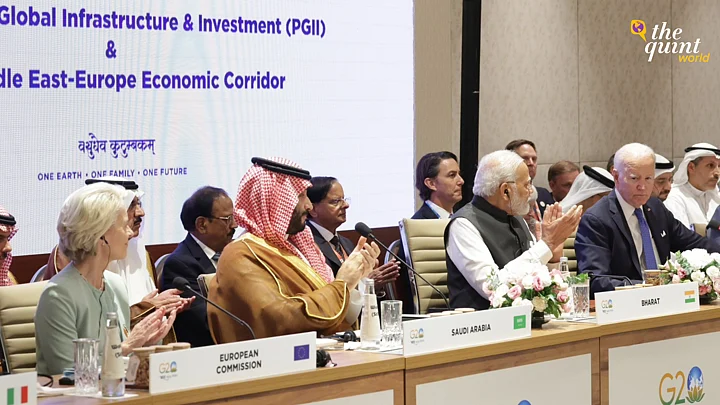Indian Prime Minister Narendra Modi, alongside European Commission President Ursula von der Leyen, United States President Joe Biden, and Saudi Arabia's Mohammed Bin Salman announced an economic corridor connecting Europe with the Middle East and India through a combination of rail and sea routes during a session at the G20 Leaders' summit in Delhi.
Who are the stakeholders?: The corridor, which aims to counter China's Belt and Road Initiative, includes the United States, United Arab Emirates, Saudi Arabia, France, Germany, Italy, and the EU with two separate corridors - East Corridor which connects India to West Asia and a North Corridor that connects West Asia to Europe.
The Agreement: An MoU signed by the leaders stated:
"It will include a railway that, upon completion, will provide a reliable and cost-effective cross-border ship-to-rail transit network to supplement existing maritime and road transport routes – enabling goods and services to transit to, from, and between India, the UAE, Saudi Arabia, Jordan, Israel, and Europe."
The Objective: The proposed corridor aims to establish seamless trade routes and ports connecting India, Saudi Arabia, the United Arab Emirates, Jordan, Israel, and the EU.
Known as the Partnership for Global Infrastructure Investment, this project has the potential to accelerate trade between India and Europe by up to 40 percent.
Moreover, it could contribute to the normalisation of relations between Israel and the Gulf states, aligning with the goals of the Biden administration.
From the horse's mouth: PM Modi said that the India-Middle East-Europe economic corridor would serve as "a beacon of cooperation, innovation, and shared progress."
Meanwhile, US President Joe Biden echoed this sentiment and called it a "game-changing investment." Von der Leyen furthered that rather than being merely a railway or cable, the initiative is "a green and digital bridge across continents and civilisations."
The Benefit: President Biden’s principal deputy national security adviser, Jon Finer, spoke to AP and provided three reasons for developing the corridor:
First, it would increase prosperity among the countries involved through an increased flow of energy and digital communications.
Second, the project would help deal with the lack of infrastructure needed for growth in lower- and middle-income nations.
Third, it could help “turn the temperature down” on “turbulence and insecurity” coming out of the Middle East, Finer said, according to AP.
“We see this as having a high appeal to the countries involved, and also globally, because it is transparent, because it is a high standard because it is not coercive,” Finer added.
What are experts saying? : According to Michael Kugelman, the Director of the South Asia Institute at The Wilson Center in Washington DC, this plan could represent a substantial response to China's BRI.
He stated, "If finalised, it would be a game changer that strengthens connectivity between India and the Middle East and would aim to counter BRI," he said on social media platform X.
Meanwhile, independent analyst Radha Kumar spoke to Al Jazeera and called it a “wonderful initiative” that will offer an alternative to the BRI.
“China’s powers are increasing so rapidly that many countries feel the need to have alternatives,” Kumar said but added that since China's global infrastructure project has its own independent existence, the new project would not necessarily undermine the BRI.
“India was not part of the Belt and Road Initiative, so this initiative gives connectivity to India," Kumar said.
(At The Quint, we question everything. Play an active role in shaping our journalism by becoming a member today.)
